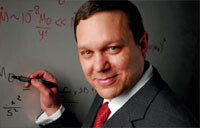Out There
Watching the history of the universe — and tracing our cosmic roots — with unprecedented precision

And so the race is on to build the largest optical telescope in the world, with three projects vying to raise enough money to build their design. Harvard’s own horse in the race, the Giant Magellan Telescope, is arguably in the lead, with key pieces of hardware already built and the tip of a mountaintop in Chile razed this March in preparation to support the 1,100-ton structure. Whoever is first to the finish line will reap the glory of imaging alien worlds with unprecedented precision and peering back at the early universe to study the first galaxies and to follow up on the Nobel Prize–winning discovery, by a pair of GSAS alumni along with a Harvard College alum, of the cosmos’s accelerating expansion.
Plans call for the GMT, as the project is known, to be composed of seven 8.4-meter mirrors that together function as a single mirror stretching 25.4 meters across. By comparison, the largest optical observatories in existence today are the twin 10-meter Keck telescopes in Hawaii. “It is hard to imagine the scale of the GMT,” says Wendy Freedman, chair of the telescope’s board and director of the Carnegie Observatories in Pasadena, California. “The whole facility will stand about the height of a 20-story building. It literally is giant.” First, though, the telescope must be built. The ambitious project is estimated to cost upwards of $700 million, and so far only $300 million or so has been raised, mainly from Australia, South Korea, and the Carnegie Institution for Science.

Another seven partners, including both Harvard and the Smithsonian Institution, have yet to decide on their level of participation. The Harvard effort is being given a strong endorsement by the Faculty of Arts and Sciences, thanks to the personal commitment of Astronomy Department chair Abraham Loeb, the Frank B. Baird, Jr. Professor of Science. Loeb is working with University officials to push the project as a central priority.
Raising money for one big project in this economy would be tough, but two larger and more expensive projects, known as the Thirty Meter Telescope (TMT) and the European Extremely Large Telescope (E-ELT), are also scrambling for funding. The competition among the different teams “ranges from collegial at technical meetings to quite cutthroat,” says Charles Alcock, director of the Harvard- Smithsonian Center for Astrophysics (CfA) and a member of the GMT board. “We’re all still seeking new partners — that’s the cutthroat part.”
But Brian Schmidt, PhD ’93, who as a faculty member at the Australian National University led the effort to get Australian funding for the GMT, says such struggles are only to be expected. “Anything worthwhile doing is always going to be competitive,” he says.
He should know. In 1994, he and a group of collaborators set out to beat a rival team led by Saul Perlmutter, AB ’81, of the University of California, Berkeley, at studying the expansion history of the universe using supernovae. The other team had a six-year head start, but Schmidt’s team raced to catch up. In 2011, Schmidt and collaborator Adam Riess, PhD ’96, shared the Nobel Prize in physics with Perlmutter for discovering that the universe’s acceleration is speeding up due to an unknown “dark energy,” rather than slowing down due to tugs from all the matter in the universe, as was expected.
So a little competition can be a good thing, and everyone recognizes that ultimately, more telescopes mean more science. “I want to see them succeed as well,” says Schmidt, who, along with Riess, used his Nobel winnings to bring unfeted collaborators to Stockholm for the ceremony and then donated the rest to charity. “I hope that in the next ten years we have all three of them up and running,” agrees Michael Bolte of the University of California Observatories, associate director for the competing Thirty Meter Telescope. “The universe is a huge place. We’re out here in the boondocks of one little galaxy trying to figure out how it all works. There’s plenty of room for lots of next-generation telescopes.”
If all three projects are built, they will differ markedly in their designs. The TMT and the E-ELT both plan to create their expansive main mirrors by assembling hundreds of relatively small hexagonal mirrors in a kind of jigsaw pattern — the so-called small segment approach. The GMT, by contrast, will use large segments; six giant circular mirrors will surround a central one like the petals of a flower. Each design has its pros and cons. “When you have big segments, you can’t fit them quite as closely together because they don’t have those straight edges,” says Bolte. “That makes control of the mirrors, making sure they’re all pointing in the right direction, a little trickier.” But Alcock says the calculations needed to ensure this control have already been worked out for the GMT, and points out that having to control a larger number of small segments — 492 for the TMT, for example — offsets the ease of having each segment closer to its neighbor. “We thought that was the tougher challenge, and they’ve made a different bet,” he says. “My guess is that both will work.”
The toughest challenge for the GMT by far is actually making the 8.4-meter mirror segments. The engineering feat takes place in a huge lab — the Steward Observatory Mirror Lab — beneath the football field at the University of Arizona in Tucson. Each individual mirror is made of about 20 tons of glass that is melted inside a honeycomb-shaped mold in a huge, spinning oven. As the oven spins, the surface of the glass curves into a desirable parabolic shape, while the honeycomb backing saves on weight and will ultimately make it easier to cool the mirror to the temperature of the air at the observatory site high in the Chilean Andes, reducing distortions in the observations.
Such huge slabs of glass have been fashioned into mirrors at the lab before. But the GMT’s flower-like design created unprecedented challenges, since each of the identical six outer petals — or “off-axis” mirrors — is asymmetrical, with one side thicker than the other. To get just the right shape, the mirror mold uses honeycomb segments of varying heights, and the cooled glass has to be polished with exquisite precision. “The outer six are the most complex surfaces ever polished,” says Alcock.
After an unexpectedly long seven years of work, the first such mirror is now finished. “If this mirror were as big as the 48 states of the USA, the error would be about the thickness of a typical coin,” Alcock says. “It’s an extraordinarily good surface.” The second mirror was cast in January, and the team expects the remaining mirrors to be finished by 2020. Each of the seven giant mirrors will also have a smaller, 1-meter counterpart hanging above it, forming a sort of “mini-me” GMT hovering over the main 25.4-meter superdish. Each of these smaller mirrors will be able to flex 1,000 times per second to correct for turbulence in the atmosphere, allowing the GMT to take images that are 10 times as sharp as the Hubble Space Telescope. “It’s a contact lens for the telescope,” says Schmidt. “It is really bleeding edge.” Indeed, so far such “adaptive optics” systems have consisted of fairly small deformable mirrors — about a third of a meter across — that were fitted on to an existing telescope, so that the light bounced through all the telescope’s mirrors first. “The GMT has a nice way of doing it — the deformable part is their secondary mirror,” says Isobel Hook, a member of the rival E-ELT team at the University of Oxford in the UK. “That’s quite difficult to do because the secondary is quite big, but if you can do it, you get extremely nice images because there are fewer reflections.”
All three of the giant telescope designs incorporate adaptive optics, and the increased sharpness of the resulting images means they will be able to spot fainter objects than they would otherwise. “The light is concentrated in a smaller little point, so it pops up against the background more easily and you can see fainter things,” Hook says.
Such eagle-eyed vision will help pick out the faint reflected light of an alien planet from the glare of its host star. The telescopes will also look for even smaller planets than can be seen directly by the subtle wobble they induce in their host stars. The CfA is designing the instrument on the GMT that will look for such wobbles from Earth-like worlds. Called G-CLEF, it will not only measure a planet’s mass but also give an estimate of its distance from its host star, and thus its temperature. That will provide important hints about how cozy the planet might be for life, says David Charbonneau, PhD ’01, one of 50 or so exoplanet researchers at the CfA. “The GMT is the facility that we are all working toward so that we can one day point to a nearby star with a potentially habitable Earth-like planet, and perhaps even make informed statements about whether or not it is inhabited,” he says.
The GMT’s giant eyes on the sky would also allow astronomers to peer back at the universe’s infancy, when the first galaxies were born. Because the light from these early sources has been traveling through space for some 13 billion years, spreading out and passing through cosmic gas along the way, very large “light buckets” like the GMT are needed to collect it. “Because of its large collecting area, the GMT will allow us to observe the first galaxies in the universe,” says Loeb. “These represent our cosmic roots, since the first stars started the process that led to our existence.” This quest to understand how the oldest and most distant galaxies first formed is “one of the most exciting frontiers in astrophysics today,” adds Loeb, who has devoted much of his own recent work to the subject and will publish the textbook The First Galaxies in the Universe (Princeton) in January. With the GMT, astronomers hope to survey the universe’s cast of characters at various times in order to understand how today’s galaxies came to be. Such surveys would also help pin down the source of the radiation that lifted the fog of neutral hydrogen gas that filled the early cosmos soon after the big bang, blocking most wavelengths of light from passing through it. Galaxies, giant black holes, or something more exotic — perhaps a new type of particle — might have zapped and ionized the gas, making space transparent to light.
The GMT would also shed light on dark energy. The quickening cosmic expansion accounts for most of the universe’s matter and energy. “So you could say we found two-thirds of the universe in 1998,” says Robert Kirshner, Clowes Professor of Science, who was Schmidt and Riess’s advisor and collaborator at the CfA and is also a member of the GMT board. “Of course,” he adds, “this grandiose claim is made a little less vibrant by the fact that we don’t know what it is.”
The nature of the lead-footed entity pushing on the accelerator remains a mystery. Is it simply an inherent property of space itself, so that every cubic inch of space fizzes with a certain amount of repulsive energy? Or is dark energy weirder and more quixotic, perhaps morphing in strength depending on the time and the place?
For the Nobel-winning work, Schmidt, Riess, and Perlmutter and their teams found that supernovae exploding within the last 7 billion years were dimmer than expected, suggesting that something has been pushing space apart ever faster over time. The GMT will allow researchers to study supernovae whose light left them about 11 billion years ago, helping to track dark energy’s behavior over more of the universe’s 13.7-billion-year history and allowing them to predict its future effects.
“If dark energy has its simplest form, the expansion of the universe will continue to accelerate, leading to a universe where we can’t see any other galaxies, ” says Kirshner. “So it’s very important to get this work done in the next few billion years — we should get going on building the GMT!”
Get the Latest Updates
Join Our Newsletter
Subscribe to Colloquy Podcast
Simplecast





